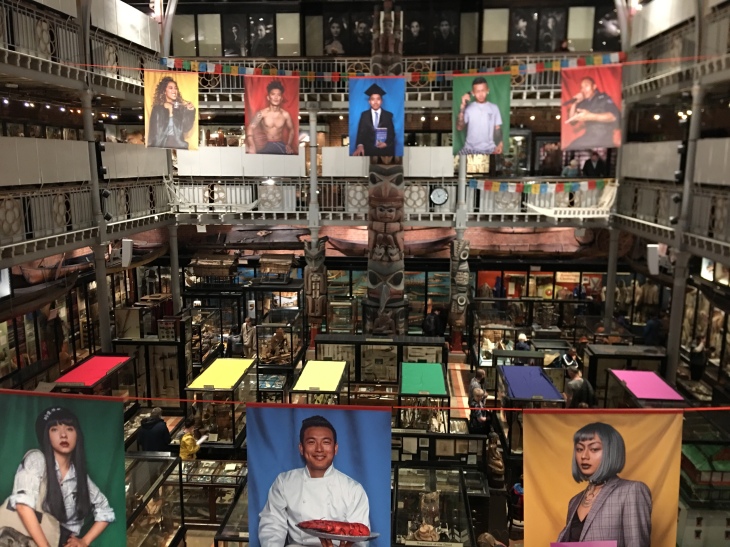
As I sat a few days ago in Oxford’s famous Pitt Rivers Museum, with its extraordinary collection of artefacts, initially established from a gift by Victorian army officer and explorer, General Augustus Pitt-Rivers, I felt hugely challenged by the content and history of the items on display.
On entering the museum’s cavernous exhibition hall, one is confronted by case after case of thematically arranged collections of clothing, religious and magical icons, masks, hats, items of burial or other ritual, skulls of vanquished enemies, and countless other ephemera from all over the world. Each item is carefully labelled both from its original arrival in the museum and with a subsequent more contemporary description and explanation.
The issue for me is that much of the museum’s content was brought to Oxford by colonialists like Pitt-Rivers, who I am sure felt that by creating these collections, he was recording for posterity the lives and cultures of those who, in the social anthropology of the time, might have been regarded as savage or barbaric people. As we now know, many of those people and their homes had highly established societies and were far from savage or barbaric. Indeed, the so-called ‘civilising’ nature of British and other European colonialism left an indelible and deeply questionable imprint on over half of the globe, in many cases eradicating or changing forever the lives of indigenous societies. Unfortunately, none of this is adequately referenced or explained in the Pitt Rivers Museum.
In visiting the museum for the first time, I was struck by an overwhelming sense that the vast majority of the artefacts don’t belong in this country. They are not part of British culture or heritage and in many cases they were taken from their original communities by force or as part of an unequal trade in return for trinkets or cash worth far less than the actual value (be that monetary, sentimental or spiritual) of the artefact. By removing a ceremonial headdress, a religious icon, or even a body in whole or part from its home, it diminished the culture and history of the indigenous people there.
Of course, by bringing those artefacts to Britain, Pitt-Rivers and other colonial explorers and anthropologists did help to vastly expand our knowledge and, to a degree, understanding of other cultures around the world. But by simply placing them in thematic display cases without context or full explanation of the culture or heritage from which they were derived, the visitor only gets a partial picture.
It is that which perhaps made me feel most uncomfortable about the Pitt Rivers Museum. Whilst there was a brief introduction to the collection and it’s difficult history, the Museum authorities have chosen over many years to maintain the original presentation rather than to seek to tell the story of the indigenous people and cultures from whom the artefacts were taken, or the colonialist context in which they were acquired.
Of course, some will argue that the Museum itself is a piece of history, an artefact demonstrating the way things used to be, both in terms of its collection and presentation, a relic of Britain’s colonial past, something which will never be repeated. There may be some truth in that, but is that justification enough to maintain the Pitt Rivers collection in its current form?
I cannot but wonder whether there would not be a stronger argument for dismantling the collection and repatriating it to the places from whence it came, into the care of local museums where they exist – or even helping to found such museums where they don’t. Would it not be better for the now sovereign nations whose culture was plundered by British colonialists to be able to put on display the relevant artefacts from the Pitt Rivers and to tell their own stories?
Some of the collection, those aspects that were more recently or more legitimately acquired, could remain in Oxford in a reformed museum which more fully tells the story of the artefacts, the cultures they come from, and of Britain’s colonial history.
And, of course, the Pitt Rivers is not the only museum containing objects which perhaps ought to be returned to their place of origin, or at least displayed with a greater explanation of their context and how they came to find themselves in Great Britain. A number of our national institutions including the British Museum and the V&A hold a vast array of artefacts which were removed from their homes against the wishes of local people, and where current generations would like them back.
Whilst I have been critical of the Pitt Rivers Museum’s presentation of its main collection and of its colonial history, it would be wrong of me not to note how pleased I was to see some more contemporary material on display, including the Performing Tibetan Identities exhibition of photographic portraits by Nyema Droma, and Lande: The Calais ‘Jungle’ and Beyond which reassembles material and visual culture from the eponymous refugee camp. The Museum also was participating in the Out In Oxford LGBTQ+ train of the University’s collections, although this was not well advertised at the Pitt Rivers, nor were the LGBTQ+ tours or talks which were taking place on the day of my visit, resulting in me not discovering them until it was too late.
Review of a visit to the Pitt Rivers Museum, Oxford, on Saturday 15 June 2019
